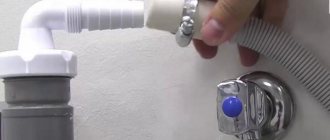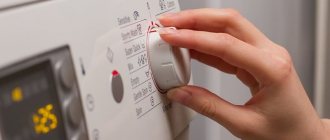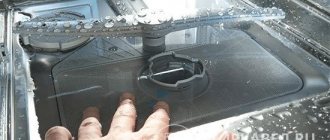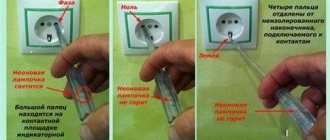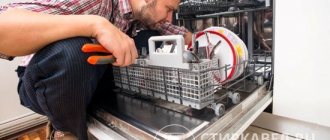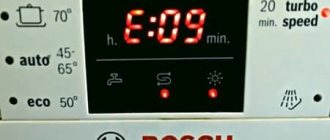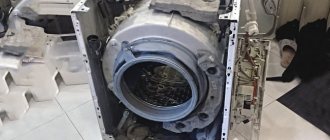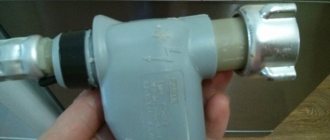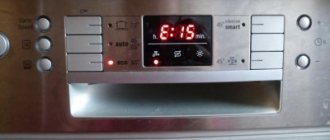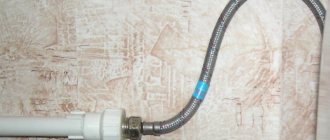Differences in dishwasher models
One of the most common differences between dishwashing machine models is the banal name of the buttons.
For example, Power SCRUB PLUS or REGULAR WASH may be called WASH or ECO depending on the dishwasher model as well as the country in which you are located. Another important difference is the presence of a display that can display error codes or its absence. In this case, the program indicator button lights up to tell you there is a problem.
As a reminder, model numbers are usually found on the top or lip of the door.
See also -
Aquastop system in dishwasher hoses to protect against leaks
Main device of the dishwasher
If you want to know how an Indesit, Bosch, Electrolux or dishwasher from any other brand works, be sure to read the material to the end. Let's start with the most important thing - the heart of the device. It is a powerful motor, sometimes called a circulation pump.
. It circulates water with detergent or rinse aid, taking it from the working chamber and returning it through the rocker arms. As for the rocker arms, they serve as rotating spray nozzles.
The largest element in a dishwasher is the working chamber. It is in it that the rocker arms are located, playing the role of washing elements. There are also baskets where dishes are placed. Baskets can be adjusted in height, and some manufacturers provide them with a transformable design, which makes it easier to store kitchen utensils of non-standard sizes.
- Filter – provides filtration and removal of solid contaminants (food residues);
- Drain pump (also known as drain pump) – removes dirty water outside the dishwasher;
- Drain hose - its purpose is clear without any comment;
- Aquastop - it is not present in all dishwashers, but it allows you to protect against leaks. The executive element of this unit is a solenoid valve located at the very end of the inlet hose.
Also in the device of any dishwasher there is the following combination:
- Inlet hose - it is connected to the water supply system, through which cold water flows into the device (or hot water, if someone connected the equipment to a hot water supply pipe);
- Solenoid valve - participates in filling water, shutting off or opening its supply;
- Water heater - classic or instantaneous. The latter helps reduce cycle times by heating water instantly rather than gradually.
Please note that in front of the inlet hose there is a simple coarse filter in the form of a metal mesh
. It plays an important role in the design of a household dishwasher, filtering out large contaminants that can enter the dishwasher from the water pipe.
As we can see, the design of dishwashers is extremely complicated. And all this despite the fact that we have not yet touched on a number of important organs, nodes and systems. Ion exchanger is a very important part responsible for water softening
. The thing is that salts dissolved in hard water interfere with normal washing. The exchanger, which operates on the basis of a special ion exchange resin, allows you to replace magnesium and calcium ions with sodium ions, resulting in softer water.
Starting a test cycle
Bosch dishwashers have a test mode that can be run as a troubleshooting measure.
The method to run this test process is similar across the Bosch range, so if your machine's functions seem to differ from those described below, it's worth experimenting as the process is similar with only minor differences. To start the test mode, hold down the POWER SCRUB PLUS and REGULAR WASH buttons. Holding down the ON/OFF button may also help. The indicator above them should blink.
You can now check the status of each program by clicking a button, or you can run a full testing period.
Press the Power SCRUB PLUS and REGULAR WASH buttons. The electronic device will start and when the selected mode has ended, if you do not have a display, the indicator on your dishwasher model will light up if a fault has been detected.
Possible equipment diseases
Some users who have absolutely no understanding of the complexities of household appliances call service centers for every little thing. But many problems can be solved on your own:
- water does not enter the unit;
- water does not drain;
- The product freezes when turned on.
In the above cases, you can try to revive the equipment yourself. First, check whether the water supply tap is open, then check whether the door is closed tightly, inspect the outlet, maybe the reason is its malfunction. Water may not drain due to clogged filters or connection pipes in the drainage system. If everything is in order there, you need a wizard to diagnose all nodes.
Meaning of fault indicators
CLEAN
Temperature sensor malfunction. If this is the case, the test cycle will be very short as the instrument will stop testing as soon as this is detected.
RINSE/DRY
Water/tank fill sensor. If this problem occurs, the test cycle will not be completed due to the fact that the dishwasher cannot determine the correct water level simply by filling/draining over and over again.
WASH
Heating fault. Check the heating element.
How to fix a dishwasher yourself?
There are two typical problems with Bosch PMM models. They are associated with water. Users often complain about the appearance of the E15 code on the display. This indicates that the Aquastop protection has been triggered. But it's not always a matter of leakage. Follow these steps:
- Tilt the PMM body back and look into the pan.
- If there is indeed water accumulated there, drain it.
- Return the float switch to the "Off" position.
Sometimes the cause of operation is incorrect placement of the inlet hose gasket. It may have moved during installation. Therefore, make the connection according to the user manual.
Dishwasher won't turn on
Have you connected your machine to the network, pressed the "Power" button, but nothing happens? The lights on the panel do not light up and no sound signals are heard. Things to check:
- Network wire. Sometimes it bends if it is pressed against the body of the dishwasher during rearrangement. If you notice damage to the insulation, do not make homemade twists. This approach can lead to a fire. Replace the cord immediately.
Meanings of error codes on the display
If your Bosch dishwasher has a display panel, after completing the test cycle, an error code will be displayed if a fault is detected.
Error codes are interpreted as follows:
0 – no errors were detected.
1 – Water sensor or filling fault.
2 – Heating fault.
4 – Water filling error. This may also appear as an F on the display during a normal cycle.
8 – Temperature sensor malfunction.
When troubleshooting a Bosch dishwasher, performing the test cycle above is a good start in diagnosing the problem. The result will give you an idea of where the problem lies and what repairs will be needed to fix the problem.
DIY dishwasher repair
As you understand, frequent causes of breakdowns are blockages or incorrect connections. Let's look at how to carry out repairs yourself, without the help of a specialist.
Clearing the blockage
If water does not flow into your Bosch dishwasher, check the following:
- turn off the water supply;
- inspect the inlet hose, it may be pinched;
- Unscrew the inlet hose and clean the filter mesh.
Additionally, the fill valve is checked - its coils are tested with a multimeter. If there is a malfunction, the part is replaced.
If the dishes are poorly washed, the problem is that the nozzles, which are sprayed with water from above, are clogged. You can clean small holes with a toothpick.
Due to blockage, water may not be flushed out after washing. The machine needs proper maintenance: before loading, the dishes must be cleared of food residues, otherwise the filter will become clogged. How to fix the situation:
- There is a filter at the bottom of the dish compartment. You need to unscrew it and clean it from dirt.
- Behind the filter there is a circulation pump. If it is clogged or broken, water is not pumped out of the machine. A new pump needs to be installed.
- The drain hose is also inspected and cleaned.
The blockages were sorted out. Now we’ll tell you how to fix the PMM if it doesn’t want to wash the dishes.
Dishwasher freezes
You have loaded dirty dishes, but the machine does not start drawing water or even freezes and does not respond to pressure. How to repair equipment:
- Check the door lock. The hole where the lock latch fits may be clogged. Try cleaning it.
- With frequent use, the “Start” button could get pressed. Try to disassemble the control panel and return the button to its place.
- The most serious malfunction is the control module. A technician can diagnose and repair it.
Basic troubleshooting
If something goes wrong when starting a wash cycle on your Bosch dishwasher and it doesn't work, stay calm. This could be a minor issue, especially if you just installed it.
Power check
Make sure the power cord is connected correctly and the switch does not trip.
Airing the hose
After this, check whether the hose is airy, especially if it was not purged before installation, it may have air bubbles inside, which retains water.
To do this, disconnect the water supply hose from the dishwasher and run some water through it before reinstalling the hose.
The wash cycle is interrupted
The Bosch dishwasher does not fill with water if the previous cycle was interrupted. Reset your dishwasher by pressing and holding the “Start” button for at least three seconds.
Depending on the model, you can also press the “Cancel-Reset” button to reset. Select a new cycle and click “Start”.
Water supply
Check the water supply hose under the sink. If it is turned off or blocked for any reason, the dishwasher will generate a program error and will not be able to fill the tank with water, even if the water supply returns within a few seconds.
Filter hose
Most Bosch dishwashers have a small filter inside the hose to prevent foreign particles from the water supply from entering the dishwasher.
Disconnect the hose and remove the filter inside. Then clean it thoroughly to remove foreign elements and reinstall it.
Water pressure
Make sure you have enough water pressure to start the dishwasher and operate the pump.
To test, take a 4 liter container and turn the tap to maximum to fill it. If you have enough water pressure to run the dishwasher, the container should fill within 30 seconds.
Fill valve problem
Inside the bottom of the dishwasher, on the back of the panel, there is a water inlet fill valve that operates using electricity.
Unplug the power cord from the outlet or turn off the power to the device using the machine. Remove the panel by unscrewing the two screws on both sides.
Remove the screws that hold the front door panel inside the dishwasher; Pull the door panel down and set it aside.
Close the door to access the water inlet valve. The fill valve has two wires that connect it to the block circuit. Check to make sure they are securely fastened.
Also check the valve for damage or leaks. If it is damaged, buy a new one using your dishwasher model number and replace it; otherwise, contact an appliance repair specialist to do it for you.
DIY dishwasher repair
As you understand, frequent causes of breakdowns are blockages or incorrect connections. Let's look at how to carry out repairs yourself, without the help of a specialist.
Clearing the blockage
If water does not flow into your Bosch dishwasher, check the following:
- turn off the water supply;
- inspect the inlet hose, it may be pinched;
- Unscrew the inlet hose and clean the filter mesh.
Additionally, the fill valve is checked - its coils are tested with a multimeter. If there is a malfunction, the part is replaced.
If the dishes are poorly washed, the problem is that the nozzles, which are sprayed with water from above, are clogged. You can clean small holes with a toothpick.
Due to blockage, water may not be flushed out after washing. The machine needs proper maintenance: before loading, the dishes must be cleared of food residues, otherwise the filter will become clogged. How to fix the situation:
- There is a filter at the bottom of the dish compartment. You need to unscrew it and clean it from dirt.
- Behind the filter there is a circulation pump. If it is clogged or broken, water is not pumped out of the machine. A new pump needs to be installed.
- The drain hose is also inspected and cleaned.
The blockages were sorted out. Now we’ll tell you how to fix the PMM if it doesn’t want to wash the dishes.
Dishwasher freezes
You have loaded dirty dishes, but the machine does not start drawing water or even freezes and does not respond to pressure. How to repair equipment:
- Check the door lock. The hole where the lock latch fits may be clogged. Try cleaning it.
- With frequent use, the “Start” button could get pressed. Try to disassemble the control panel and return the button to its place.
- The most serious malfunction is the control module. A technician can diagnose and repair it.
